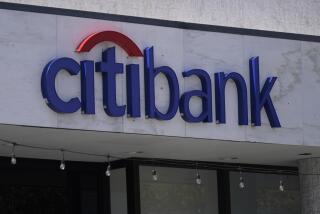New Study Calls Regulators Soft on Lending Bias : Banking: The Senate report says most institutions get good ratings from agencies despite complaints that minorities can’t get loans from the same institutions.
- Share via
WASHINGTON — Federal agencies charged with monitoring compliance with a law requiring financial institutions to meet the needs of their communities have given the vast majority of institutions high ratings, in conflict with evidence that institutions provide poor service to minorities, according to a report to be presented to a congressional committee today.
Nearly 90% of the nation’s banks and thrifts received outstanding or satisfactory grades from federal regulators for meeting the financial needs of their communities, despite widespread problems encountered by minority group members seeking loans, the report said.
The report shows regulators aren’t doing an effective job of enforcing the law requiring lenders to be responsive to local needs, said Sen. Alan Cranston (D-Calif.), who ordered the study for a hearing of the housing subcommittee of the Senate Banking Committee.
“The glowing assessments provided by the agencies conflict with reports the subcommittee has received from community groups, local governments and studies about the banks’ performance,” Cranston said in a statement prepared for today’s hearing.
The regulators’ “performance is unacceptable, and I can find no reasonable excuse for the agencies failure to meet their obligations to enforce the law properly. . . . We saw clearly in Los Angeles six months ago what can happen when a community that has been systematically disinvested erupts in rage and frustration,” Cranston said.
His staff reviewed more than 250 reports filed by federal financial regulators between July, 1990, and July, 1992, that evaluated the performance of banks and S&Ls; under the Community Reinvestment Act. The act requires lenders to meet the credit needs of their entire communities, including low- and moderate-income neighborhoods.
The CRA was adopted in 1977, but became an important focus of attention only in the last three years after Congress ordered public disclosure of the ratings, and said that approval of mergers or expansions could be linked to CRA performance.
The regulators examined 9,338 banks and thrifts. They gave 89.9% of the institutions ratings of full approval, either outstanding (939), or satisfactory (7,465).
The remaining institutions were rated “needs to improve” (939), or in “substantial non-compliance” (85). Banks were evaluated by the Office of the Comptroller of the Currency, the Federal Deposit Insurance Corp. and the Federal Reserve Board. The Office of Thrift Supervision rated the S&Ls.;
The toughest scrutiny came from the OTS, which gave an outstanding or satisfactory designation to 81% of the institutions it examined, compared to 86% for the Comptroller and 91% for the both the FDIC and the Fed.
Too often, the banks and the regulators view efforts to lend in low-income and minority neighborhoods as charity work, rather than as an integral part of the business of lending, said Ryan Conroy, the legislative aide who studied individual, detailed CRA reports for banks and thrifts. “It has a low priority for the regulators,” she said.
For the lenders doing a good job, “it must be frustrating” for institutions with a deserved outstanding rating to know that other lenders doing much less are also graded outstanding, she said.
A recent Times’ study of lending patterns in Los Angeles County showed that S&Ls; were much more active than banks in lending to blacks and other minority group members.
Great Western Bank was the largest lender to blacks in Los Angeles County, with 438 loans in 1990, according to The Times’ study. It received an outstanding rating from the OTS. During the same year, Bank of America, the biggest financial lender in the state, had 100 loans to blacks, and Wells Fargo had 13 loans. Yet both banks also received outstanding CRA ratings from their federal evaluator, the Comptroller of the Currency.
The Times’ study also showed that blacks, no matter how much money they made, were less likely than whites, Asians and Hispanics to be approved for home mortgage loans.
Among the 25 biggest California institutions examined by each agency, according to housing subcommittee research, the following institutions had less than satisfactory ratings: Farmers & Merchants Bank of Long Beach; California Korea Bank; American International Bank; General Bank; Coast Federal Bank; Glendale Federal Bank; Homestead Savings; Union Federal Savings; World Trade Bank; United National Bank; Pacific National Bank; El Capitan National Bank, and City National Bank. A substantial non-compliance rating was given to Mercantile National Bank in Los Angeles and Merchants National Bank in Sacramento.
More to Read
Sign up for Essential California
The most important California stories and recommendations in your inbox every morning.
You may occasionally receive promotional content from the Los Angeles Times.










